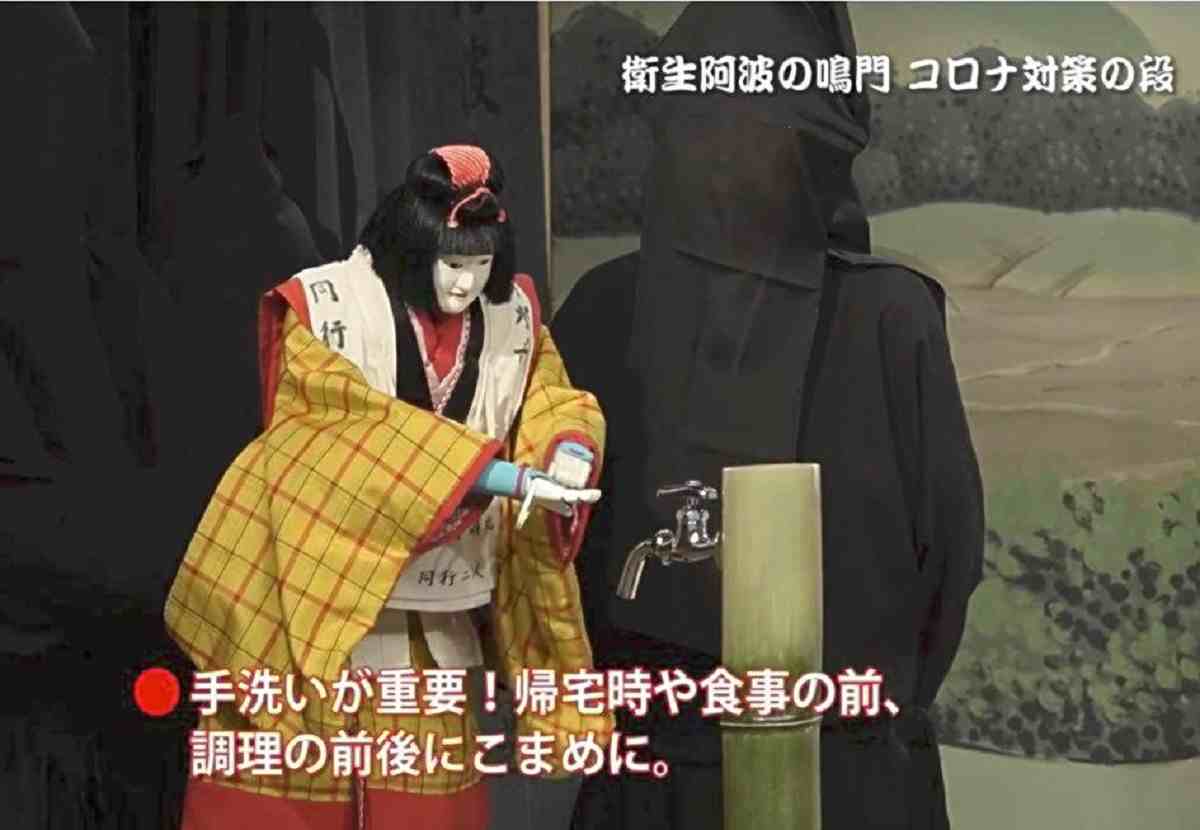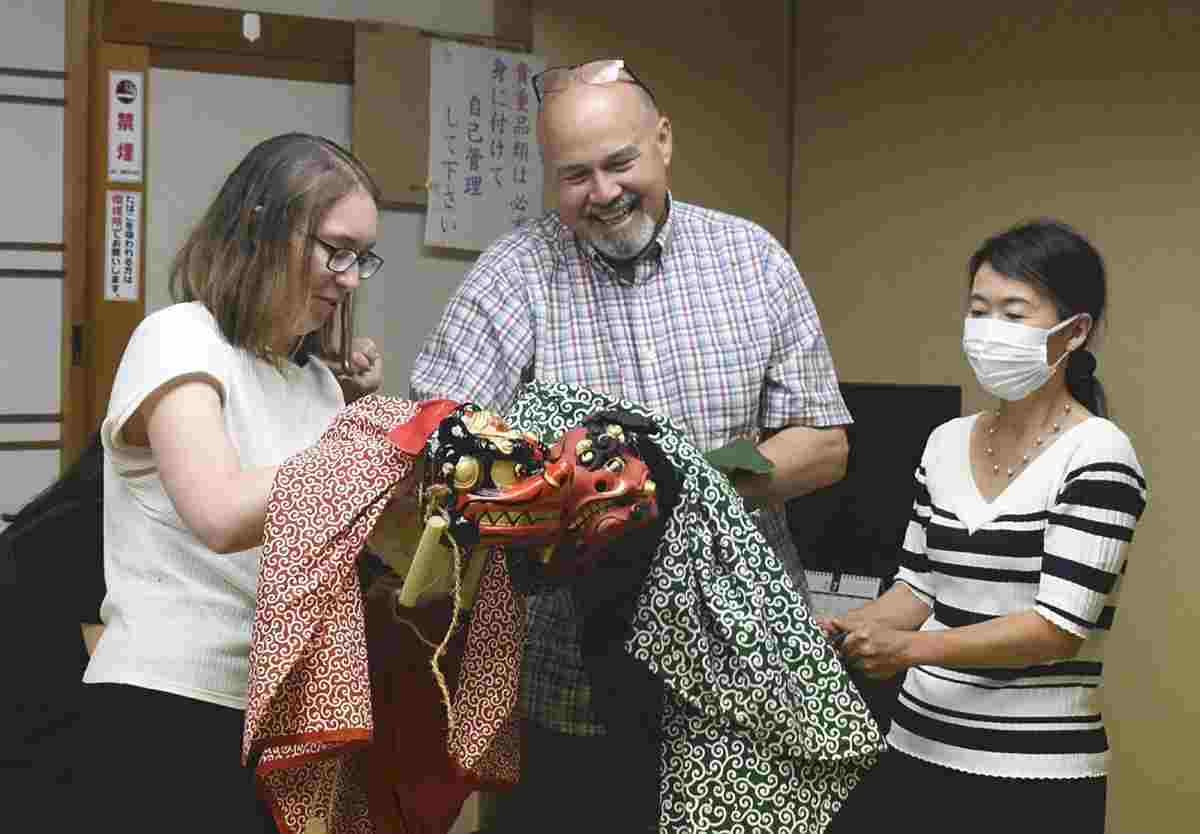
In this scene from “Eisei Awa no Naruto : Korona Taisaku no Dan,” the caption says: “Hand washing is important! Wash frequently when coming home, when eating and before and after preparing food.”
18:29 JST, March 5, 2021
TOKUSHIMA — Not willing to let the prolonged coronavirus crisis keep their traditional craft off the stage, a group of ningyo joruri puppeteers in Tokushima Prefecture released a special video on their website last year.
Ningyo Joruri — often called simply joruri or bunraku — is a Japanese traditional art form that combines narrative recitation, shamisen music and puppets. The video shows puppets washing their hands before entering a house and wearing masks when talking.
The video, titled “Eisei Awa no Naruto : Korona Taisaku no Dan” (Hygiene in Naruto of Awa region : Scene of countermeasures against coronavirus), is based on the traditional joruri tragedy “Keisei Awa no Naruto : Junrei Uta no Dan,” which is associated with this part of the Shikoku region. Awa is the old name of present-day Tokushima Prefecture and Naruto is one of the cities in the prefecture.
The new work updates the old story by including tips for the prevention of infections.
Troupes around the prefecture
The puppet theater art in Tokushima is said to have come from Awaji Island, now part of Hyogo Prefecture.
After the island became the domain of the Tokushima clan in 1615, the ruling Hachisuka family promoted indigo trading and joruri. For the latter, they invited puppet theaters from Awaji to perform. It is believed that this is how joruri spread throughout Tokushima.
Even today, local residents form puppet theaters, performing all around the prefecture.
“The number of puppet theaters in Tokushima is the highest in Japan. Joruri has taken root as an attractive traditional culture here,” said Kenji Sato, 59, director of the Tokushima Prefectural Awa Jurobe Yashiki (Puppet Theater and Museum).
The museum, located in Tokushima City, serves as a center for the transmission of traditional performing arts in the region. It used to hold regular performances twice a day. But after the outbreak began, opportunities for puppet troupes and tayu narrators to present their works were lost one after another because of the museum’s temporary closure.
Ningyo joruri is regarded as a comprehensive art form, as it combines the three arts of narration, shamisen and puppets. Manipulating a single puppet requires three people, dressed in black clothes to hide in the background, working closely together in unison.
However, many members of the puppet troupes in the prefecture are aging. Suspending their activities altogether could lead to their retirement. Sato felt an unprecedented sense of crisis.

Martin Holman, center, teaches people how to manipulate a lion puppet in Tokushima City.
Hardship brings new style
While the museum was closed, he turned his attention to putting online a piece that called for the prevention of infections.
In contrast to a stage show, as a video presentation it’s possible to finely focus on the gestures of the puppets, such as washing their hands or turning on a water tap. Sato found he was able to convey the message in a different way from a performance on stage.
“If it hadn’t been for the pandemic, I wouldn’t have tried it,” he said.
During the autumn and winter, more schools visited the museum on school trips than in previous years. Many of them changed their destinations from the Kansai region due to the spread of infections.
“Because of the constraints, there have been new challenges and changes in values,” Sato said. “Even though the coronavirus crisis is going to be around for a long time, we want to use this hardship as an opportunity to promote the appeal of ningyo joruri by, for example, enhancing our programs for the younger generation, who may have not been interested in it before.”
Joruri
A traditional art form that combines narrative recitation, performed by a narrator known as the tayu, shamisen and puppets, each of which is controlled by three performers. Joruri without puppets — only narration and shamisen — is also an art form, being called su-joruri.
Joruri emerged in the early Edo period (1603-1867) and during its heyday saw the narrative works of Takemoto Gidayu, who originated a musical narration style called gidayu-bushi, and the famed works of playwright Chikamatsu Monzaemon, including a masterpiece “Sonezaki Shinju” (Love suicide at Sonezaki).
U.S. impresario founds his own puppet troupe
An American man fascinated by Japanese puppet theater moved to Tokushima to form his own theater company. Martin Holman, 62, from Kentucky, said he was attracted by joruri when he was in college, after watching a video about it in class.
Although the facial expressions of joruri puppets never change, a wide range of emotions can be expressed with delicate movements of their arms and legs. Holman said he was impressed by the marvelous technique of the art form.
Holman became a professor of Japanese literature in the United States. During that time, he also formed and performed in a puppet theater company with his students. He moved to Kobe in 2018 to work as a university lecturer, and later moved to Tokushima City in September 2019 because joruri is popular there.
“Joruri is alive as a popular art form in this region. The local residents practice it on a regular basis and perform it at festivals,” Holman said.
After immigrating to Tokushima, he formed the puppet theater company Tokubei-za, which has grown to about 15 members.
“In the past, joruri would have a special meaning for people to recover from fatigue during spring and autumn festivals, after hard days of working on the farm,” Holman said. “I’d be happy if people smile today as much as they used to.”
Related Tags
"Features" POPULAR ARTICLE
-

Sanrio to Open Museum in Yamanashi Pref. Dedicated to Founder, Exhibits Include Hello Kitty, Other Characters
-

Autumn Foliage Surrounds Visitors to Tokyo’s Showa Kinen Park
-

My Daughter No Longer Speaks to Me, But I Want to See Her and My Grandchild
-

Kumamoto: Public Bath Refurbished as Library Where You Can Chat, Take Photos
-

Frozen Vegetables: Demand Rises for Convenient, Tasty Domestic Produce
JN ACCESS RANKING
-

Tokyo Economic Security Forum to Hold Inaugural Meeting Amid Tense Global Environment
-

Keidanren Chairman Yoshinobu Tsutsui Visits Kashiwazaki-Kariwa Nuclear Power Plant; Inspects New Emergency Safety System
-

Imports of Rare Earths from China Facing Delays, May Be Caused by Deterioration of Japan-China Relations
-

University of Tokyo Professor Discusses Japanese Economic Security in Interview Ahead of Forum
-

Japan Pulls out of Vietnam Nuclear Project, Complicating Hanoi’s Power Plans


























